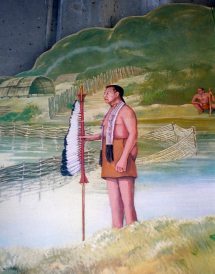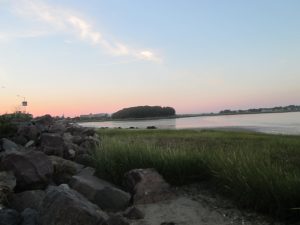
Chickataubut was the Sac’hem of the Neponset Band of the Indigenous Massachusett people in 1620. He had many residences throughout his territory. His principal Summer Seat was at Passanageset (now Quincy). He buried his Mother there. This suggests that this was his mother’s village and perhaps the birthplace of Chickataubut. Moswetusett Hummuck also in Quincy was his secondary summer seat. In addition to Quincy, the Neponset Tribe occupied the region of what now includes the places now called Wollaston, Milton (Neponset), Dorchester, Braintree, Weymouth, Hingham, Nantasket, Hull, Cohasset, Duxbury, Scituate, Plymouth, the Boston harbor Islands and many other villages along the southeast coast. Chickataubut’s winter inland seat and the winter home of his people was at Massawachusett, (the place of many great hills) and from where the Massachusett people took their name) at what is now called the Blue Hills and included what is now called Randolph, Canton, Stoughton, Dedham, Brockton, Bridgewater, to name just a few places occupied by Massachusett bands in winter that are familiar to many.
“In 1620 when the forefathers landed at Plymouth they found the Indian chief Chickataubut in full possession of all the country.” [1] “His Court was held at Braintree, Which included the present towns of Randolph and Quincy and it was never denied in his lifetime or that of his grandson, that he held an undisputed possession. In 1621 he went to Plymouth and signed a treaty with the English.” [2] “He consented to the occupancy of Dorchester to the English in 1630 and it was paid for to his satisfaction.” [3]
In 1630 Dorchester covered a much larger area than it does today. Chickataubut consented to the occupancy of Dorchester (occupancy, not sale, as evidenced by Dorchester’s English inhabitants still seeking a deed from his son Josiah Wampatuck in 1666 (They never received it). [4] It is most probable that Chickataubut considered the payment he received as “tribute” such as he received from the other lesser tribes occupying Massachusett Territory. The same kind of consent he agreed to in the treaty with the English at Plymouth in 1621. The sale of land was an unheard of concept for the Indigenous Massachusett. Some of the earliest disputes between the English and the Massachusett arose as a result of the English mistaking their tributes to the Massachusett Sac’hems to be payment for the sale of Massachusett Territorial Land.
In 1631 Gov. Thomas Dudley, Deputy Governor of Massachusetts Bay Colony, speaking of Chickataubut writes; “Upon the River of Neponset, near to the Massachusetts fields dwelled Chickataubut”. He also writes, “This man least favors the English of any Sagamore (for so are the Kings with us called as they are Sachems southwards).* We are acquainted with by reason of the old quarrel between him and those of Plymouth wherein he lost seven of his best men”. [5]
In a history written by William Hubbard, he tells of “a great rendezvous of all the Massachusetts Indians at the seat of the great Sagamore”. [6]

Beginning with the Charter of the Massachusetts Bay Colony in 1629, “by the grace of King Charles of England” and his claiming of “New England, America and everything in it”*, The Indigenous Massachusett were officially a targeted people. Having already suffered through devastating plagues that had drastically reduced their numbers, and a Massacre at Wessagusset (Weymouth), the order from King Charles was “to reduce or convert to submission the indigenous people of New England”.*
Knowing now of this early document mandating the reduction or conversion of the indigenous people of New England , “We must not succumb to the romantic notions that the invading English were peaceful people looking to live in peace and harmony with the Indigenous Massachusett People who had inhabited these lands for thousands of years.” [7] With the sanction of their English King the English invaders were more than ready to “reduce” (kill) the Indigenous people who refused to submit to them.
Along with the invading pilgrims at Plymouth and later Weymouth, Chickataubut also had to deal with the leaders of the Massachusetts Bay Colony who had settled in the midst of his territory and who were mandated to “reduce or convert to submission”* his people. Chickataubut was not to be converted to submission. He controlled a territory rich in resources, from plentiful whaling /fishing waters and hunting grounds that produced meat and skins, for food clothing and trade, to large and fertile fields of corn, beans, squash and other produce, that along with the fish and meat, fed his people in both summer and winter. The Neponset Quarries produced materials for tool making and weapons for tribal use and for trade. “Chickataubut did not form treaties or agreements that would lead to his ultimate inability to deal effectively with the English from a place of power.” [8]
[1], [2], [3], [4] Daniel Huntoon’s History of Canton, University Press, 1893 [5] Deputy Governor Thomas Dudley’s letter to the Countess of Lincoln, (England), Boston, New England, March 12, 1630 *Sac’hem, Sagamore , Sagamo are all regional variations of the same title. [6] William Hubbard’s History 1681 [7], [8] Gil (Feather on the Moon) Solomon, Lead Sac’hem of the Massachusett Tribe at Ponkapoag
*The Charter of Massachusetts Bay 1629; American Colonist’s Library- Primary Source Documents, The Avalon Project, Yale Law School
